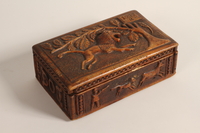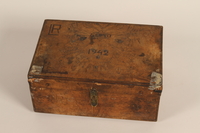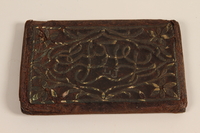Overview
- Brief Narrative
- Handmade engraved metal box used in Łódź, Poland, to collect funds for charity. The address, 20 Wolborska, engraved on the box, is the location of the main synagogue in Łódź which was set on fire in November 1939 by the German forces who occupied the city that September. A tzedakah box is used by Jewish communities as a physical reminder to be charitable and help others. The message on this box asks contributors to show support by ushering in a new Torah. On September 1, 1939, Nazi Germany invaded Poland and, one week later, occupied Łódź. They renamed it Litzmannstadt and in February 1940 relocated all the Jews, roughly 100,000 people, into a sealed ghetto. Prewar Łódź was a thriving industrial city and the ghetto continued to be an important manufacturing center. Daily life and social and economic activity in the ghetto was handled by a Council of Jewish Elders who reported to the German authorities. There were continual food shortages and death from starvation was common. By September 1942, the Germans has deported the majority of the residents to Chelmno killing center. The ghetto was destroyed in May 1944.
- Date
-
use:
approximately 1939
- Geography
-
use:
Litzmannstadt-Getto (Łódź, Poland);
Łódź (Poland)
- Credit Line
- United States Holocaust Memorial Museum Collection, Gift of Rafal Imbro
Physical Details
- Classification
-
Containers
- Category
-
Metal containers
- Object Type
-
Collection boxes (Fund raising equipment) (lcsh)
- Physical Description
- Handmade, shallow, rectangular silver colored metal box with rounded corners and remnants of nickel plated brass on the hinged, shallow lipped lid. The lid separates vertically in the center into two sections and is hinged on both ends with plates soldered to the base interior and to the lid. It opens outward to reveal a single interior compartment. The lid is incised with a decorative line border. An oval latch with a knob is riveted to the center edge of the right lid; it pivots onto the left lid to secure the box. When closed, the left lid rests upon a thin plate soldered to the underside of the right lid. The right lid exterior has engraved Polish text; the left lid has Hebrew and Yiddish text engraved on the underside. The letters are decorated with incised lines. The surface is scratched and has some green corrosion.
- Dimensions
- overall: Height: 1.875 inches (4.763 cm) | Width: 6.500 inches (16.51 cm) | Depth: 5.375 inches (13.653 cm)
- Materials
- overall : brass, nickel
- Inscription
- lid exterior, right side, engraved : POPIERAJCIE HACHNOSAS KALO GMULAS CHASODIM WOLBORSKA 20 [Support for ushering in a new Torah and giving charity Wolborska 20]
lid interior, left side, engraved : Hebrew text [Support for a new Torah(?possibly for brides) and giving charity Wolborska 20]
Rights & Restrictions
- Conditions on Access
- No restrictions on access
- Conditions on Use
- No restrictions on use
Keywords & Subjects
Administrative Notes
- Legal Status
- Permanent Collection
- Provenance
- The box was donated to the United States Holocaust Memorial Museum in 2004 by Rafal Imbro.
- Record last modified:
- 2022-08-31 12:33:28
- This page:
- https://collections.ushmm.org/search/catalog/irn522465
Download & Licensing
In-Person Research
- By Appointment
- Request 21 Days in Advance of Visit
- Plan a Research Visit
- Request to See This Object
Contact Us
Also in Rafal Imbro collection
The collection consists of three boxes, a wallet, documents, identification cards, and receipt books relating to the experiences of Jewish people living in Łódź and Kielce, Poland, before and during the Holocaust. Some of these materials may be combined into a single collection in the future.
Date: 1923-1943

Carved wooden box handmade and used in the Łódź Ghetto
Object
Handmade carved wooden box used in the Jewish ghetto in Łódź, Poland. It has the year 1932 etched in the lid with a later addition of the year 1940 and the name Estera Tannenbaum Hersz. Nazi Germany invaded Poland on September 1, 1939, and one week later occupied Łódź. They renamed it Litzmannstadt and in February 1940 relocated all the Jews, roughly 100,000 people, into a sealed ghetto. Prewar Łódź was a thriving industrial city and the ghetto continued to be an important manufacturing center. Daily life and social and economic activity in the ghetto was handled by a Council of Jewish Elders who reported to the German authorities. There were continual food shortages and death from starvation was common. By September 1942, the Germans had deported the majority of the residents to Chelmno killing center. The ghetto was destroyed in May 1944.

Handcrafted wooden box with inlaid text and a mirror made in the Łódź Ghetto
Object
Handmade wooden box with a folding mirror crafted and used in the Jewish ghetto in Łódź, Poland. It haand inlaid letters spelling Getto 1942 Litzmannstadt. Nazi Germany invaded Poland on September 1, 1939, and one week later occupied Łódź. They renamed it Litzmannstadt and, in February 1940, relocated all the Jews, roughly 100,000 people, into a sealed ghetto. Prewar Łódź was a thriving industrial city and the ghetto continued to be an important manufacturing center. Daily life and social and economic activity in the ghetto was handled by a Council of Jewish Elders who reported to the German authorities. There were continual food shortages and, with the severe overcrowding, death from starvation and disease was common. By September 1942, the Germans had deported the majority of the residents to Chelmno killing center. The ghetto was destroyed in May 1944.

Brown leather wallet with inlaid floral decorations handcrafted and used in the Łódź Ghetto
Object
Hand decorated wallet crafted and used in the Jewish ghetto in Łódź, Poland. Nazi Germany invaded Poland on September 1, 1939, and one week later occupied Łódź. They renamed it Litzmannstadt and in February 1940 relocated all the Jews, roughly 100,000 people, into a sealed ghetto. Prewar Łódź was a thriving industrial city and the ghetto continued to be an important manufacturing center. Daily life and social and economic activity in the ghetto was handled by a Council of Jewish Elders who reported to the German authorities. There were continual food shortages and, with the severe overcrowding, death from starvation and disease was common. By September 1942, the Germans had deported the majority of the residents to Chelmno killing center. The ghetto was destroyed in May 1944.
Kielce Ghetto Jewish Welfare Committee photograph album
Document
Consists of one photograph album with cloth covers and paper jacket with embossed design in blue and white. Contains 47 black and white photographs and 4 loose inserts. The pages are decorated with hand painted graphics. Inscription on first page, "Z.K.O.M., W. Kielcach" and the second page,"1 styczen 1942." Photograph album prepared by the employees of the Jewish Council in the Kielce ghetto for the Chairman of the Judenrat, Mr. Hermann Levi. The album is titled: Z.K.O.M (Zydowski Komitet Opiekunczy Miejski) Jewish Welfare Committee in Kielce and is dated 1 January 1942. It includes photographs documenting the Welfare Committee activities and three ID cards indicating statistics relating to its activities.
Rafal Imbro papers
Document
The papers consist of documents, identification cards, and receipt books relating to the experiences of Jews in Łódź and Kielce, Poland, before and during World War II.



